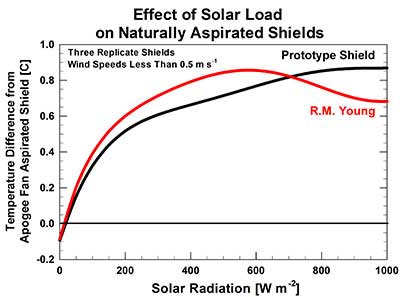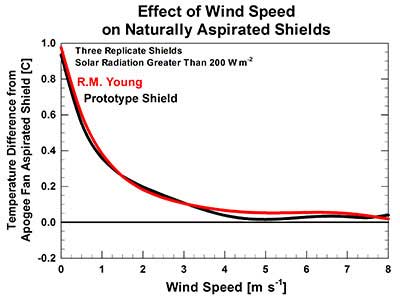Accuracy Differences in Naturally vs Fan-Aspirated Shields
The use of multi-plate, naturally ventilated radiation shields for air temperature measurements results in significant errors in moderate solar radiation when winds speed is less than 3 to 4 m s-1. Testing conducted by Campbell Scientific Inc. was used to compare static, multi-plate shields to an Apogee fan-aspirated shield (model TS-100) (Figure 1). These data show that air temperature error in static shields increases as solar load increases and wind speed decreases. A fan-aspirated solar radiation shield is required for accurate measurement of air temperature under all environmental conditions (Huwald et al., 2009).


Figure 1: Temperature increase in two models of naturally-aspirated multi-plate radiation shields relative to an Apogee model TS-100 fan-aspirated radiation shield. Plots in each graph are temperature differences determined by fitting polynomials to six months of data. Left: Temperature differences with wind speed data filtered for wind speeds less than 0.5 m s-1. Right: Temperature difference versus wind speed. Data filtered for shortwave radiation greater than 200 W m-2. Temperatures in the reference TS-100 fan-aspirated shield were measured with an Apogee model ST-110 thermistor, while temperatures in naturally-aspirated shields were measured with Campbell Scientific model 109SS thermistors.
Huwald, H., C.W. Higgins, M.O. Boldi, E. Bou-Zied, M. Lehning, and M.B. Parlange, 2009. Albedo effect on radiative errors in air temperature measurements. Water Resources Research 45, W08431, doi:10.1029/2008WR007600.
